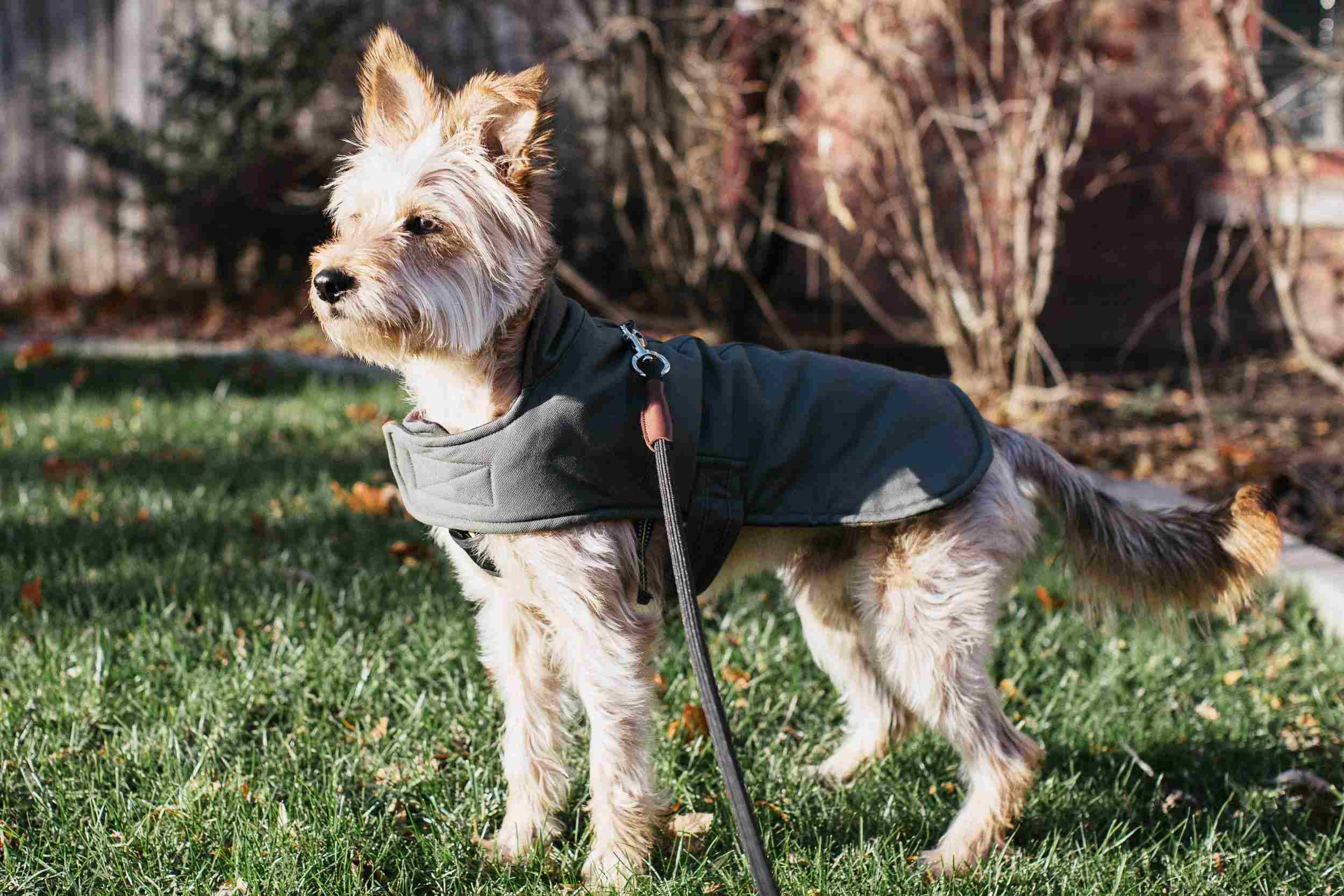Home>Weather and Climate>Determining The Optimal Temperature For Walking Your Dog


Weather and Climate
Determining The Optimal Temperature For Walking Your Dog
Published: March 2, 2024
Discover the ideal weather and climate conditions for walking your dog. Learn how to determine the optimal temperature to keep your furry friend happy and healthy.
(Many of the links in this article redirect to a specific reviewed product. Your purchase of these products through affiliate links helps to generate commission for Temperatures.com, at no extra cost. Learn more)
Table of Contents
Introduction
When it comes to taking your furry friend for a walk, the temperature outside plays a crucial role in ensuring their comfort and well-being. As a responsible pet owner, it's essential to understand the impact of temperature on your dog's health and behavior. Whether you're strolling through a serene park or navigating bustling city streets, the temperature can significantly influence your dog's walking experience.
Understanding the optimal temperature for walking your dog is not only beneficial for your pet's physical health but also for their mental stimulation and overall happiness. As we delve into the intricacies of temperature and its effects on dogs, it becomes evident that various factors come into play when determining the ideal conditions for a leisurely stroll with your canine companion.
From the gentle warmth of a spring morning to the crisp chill of a winter afternoon, each season brings its unique set of considerations for dog owners. By gaining insight into the significance of temperature and its implications for dog walking, you can make informed decisions that prioritize your pet's well-being while fostering a deeper bond through shared outdoor experiences.
As we explore the multifaceted nature of temperature and its impact on dog walking, it becomes apparent that a harmonious balance between environmental conditions and your dog's comfort is essential. By considering various factors and understanding the potential health risks associated with extreme temperatures, you can ensure that every walk with your dog is a safe, enjoyable, and enriching experience for both of you.
Read more: Ideal Indoor Temperature For Dogs: Ensuring A Comfortable Environment For Your Canine Companion
The Importance of Temperature for Dog Walking
The temperature plays a pivotal role in determining the quality of your dog's walking experience. Just as humans seek comfort and safety in different weather conditions, dogs also have specific temperature preferences that can significantly impact their well-being during walks. Understanding the importance of temperature for dog walking is essential for ensuring that your furry companion remains healthy, happy, and comfortable throughout the outdoor excursion.
Temperature directly affects a dog's physical comfort and overall health. In hot weather, dogs are susceptible to heat exhaustion and dehydration, making it crucial to avoid walking them during the peak heat of the day. Conversely, in cold temperatures, dogs may experience discomfort, especially those with short coats or low body fat. Monitoring the temperature and considering your dog's breed, age, and health status is essential for providing a safe and enjoyable walking experience.
Moreover, the temperature can influence a dog's behavior and energy levels. In excessively hot weather, dogs may exhibit signs of fatigue, reluctance to walk, or even heat-related distress. On the other hand, in cold temperatures, dogs may become more energetic to generate body heat, leading to a more vigorous walking experience. Understanding these behavioral changes in response to temperature variations is crucial for tailoring the walking routine to your dog's specific needs.
Additionally, the temperature directly impacts the pavement and ground surfaces that your dog walks on. In hot weather, asphalt and concrete can reach scorching temperatures, potentially causing paw pad burns and discomfort. In colder temperatures, icy or snowy surfaces can pose slipping hazards and discomfort for your dog. Being mindful of these surface conditions and their temperature-related effects is vital for ensuring your dog's safety and well-being during walks.
By recognizing the significance of temperature for dog walking, pet owners can make informed decisions to create a comfortable and safe walking environment for their furry companions. Whether it's adjusting the walking schedule to avoid extreme temperatures, providing protective gear for varying weather conditions, or choosing suitable walking surfaces, understanding the impact of temperature is crucial for promoting a positive and enriching walking experience for dogs.
In essence, the importance of temperature for dog walking extends beyond mere environmental conditions; it directly influences a dog's physical comfort, behavior, and safety during outdoor activities. By prioritizing temperature considerations and tailoring the walking routine to accommodate your dog's specific needs, you can ensure that every walk is a delightful and beneficial experience for both you and your beloved canine companion.
Factors to Consider When Determining the Optimal Temperature
When determining the optimal temperature for walking your dog, several crucial factors come into play, each contributing to the overall comfort, safety, and well-being of your furry companion. Understanding and considering these factors can help you make informed decisions that prioritize your dog's needs during outdoor excursions.
-
Breed and Coat Type: Different dog breeds have varying tolerance levels to temperature extremes. Breeds with thick coats, such as Huskies and Malamutes, are better equipped to handle colder temperatures, while short-haired breeds, like Chihuahuas and Greyhounds, may be more sensitive to chilly weather. Additionally, dogs with thin fur or exposed skin are more susceptible to sunburn and heat absorption in warmer temperatures. Considering your dog's breed and coat type is essential for determining the optimal temperature for walking.
-
Age and Health: The age and health status of your dog play a significant role in their temperature tolerance. Puppies and senior dogs are more vulnerable to temperature extremes and may require extra care during walks. Similarly, dogs with underlying health conditions, such as respiratory issues or arthritis, may be more sensitive to temperature fluctuations. Understanding your dog's age and health status enables you to tailor the walking routine to accommodate their specific needs.
-
Physical Fitness: The physical fitness and activity level of your dog influence their ability to regulate body temperature during walks. Dogs that are overweight or have limited exercise may struggle to cope with extreme temperatures. Conversely, highly active dogs may require additional hydration and rest breaks in hot weather. Considering your dog's physical fitness level helps in determining the optimal temperature range for their outdoor activities.
-
Time of Day: The time of day significantly impacts the temperature and environmental conditions during walks. Early morning and late evening walks often offer cooler temperatures, making them ideal for avoiding midday heat or chilly evenings. By choosing the right time of day for walks, you can ensure that your dog remains comfortable and safe in varying weather conditions.
-
Walking Surface: The type of walking surface, such as asphalt, concrete, grass, or sand, can absorb and retain heat differently. In hot weather, asphalt and concrete surfaces can become excessively hot, potentially causing discomfort or paw pad burns for your dog. On the other hand, in cold temperatures, icy or snowy surfaces may pose slipping hazards. Considering the walking surface temperature is crucial for providing a safe and enjoyable walking experience for your dog.
By taking these factors into account, you can determine the optimal temperature for walking your dog and create a walking routine that prioritizes their comfort, safety, and overall well-being. Tailoring the walking experience to accommodate your dog's specific needs ensures that every outdoor excursion is a positive and enriching experience for both you and your beloved canine companion.
Health Risks of Walking Your Dog in Extreme Temperatures
Walking your dog in extreme temperatures poses significant health risks that can adversely affect your furry companion's well-being. Whether facing scorching heat or freezing cold, it's crucial to be aware of the potential dangers associated with extreme temperatures and take proactive measures to safeguard your dog's health during outdoor activities.
In hot weather, dogs are susceptible to heat-related illnesses, including heat exhaustion and heatstroke. Excessive heat can lead to dehydration, elevated body temperature, and difficulty in regulating internal heat, putting your dog at risk of serious health complications. Additionally, hot pavement and surfaces can cause burns to your dog's paw pads, leading to pain and discomfort. Prolonged exposure to high temperatures can also result in heat-induced fatigue, impacting your dog's energy levels and overall well-being.
Conversely, walking your dog in freezing temperatures presents its own set of health risks. Dogs are vulnerable to hypothermia and frostbite when exposed to cold weather for extended periods. Breeds with short coats or low body fat are particularly susceptible to the chilling effects of cold temperatures, potentially leading to shivering, lethargy, and discomfort. Moreover, icy or snowy surfaces can pose slipping hazards, increasing the risk of injuries during winter walks.
Understanding the health risks associated with extreme temperatures is essential for responsible dog owners. By recognizing the potential dangers, you can take proactive steps to mitigate these risks and ensure a safe walking environment for your dog. This may involve adjusting the walking schedule to avoid peak heat or cold periods, providing protective gear such as dog boots or a cooling vest, and being mindful of your dog's behavior and physical cues during walks.
Furthermore, it's crucial to be aware of the signs of heat exhaustion, heatstroke, hypothermia, and frostbite in dogs. Symptoms such as excessive panting, drooling, weakness, disorientation, shivering, and pale skin can indicate temperature-related health issues. Being vigilant and responsive to these signs enables you to take prompt action to protect your dog's health and well-being during walks in extreme temperatures.
In essence, the health risks of walking your dog in extreme temperatures underscore the importance of prioritizing your pet's safety and comfort during outdoor excursions. By being mindful of temperature-related dangers and taking proactive measures to mitigate risks, you can ensure that every walk with your dog is a positive and beneficial experience, free from the adverse effects of extreme weather conditions.
Tips for Walking Your Dog in Different Temperatures
Walking your dog in varying temperatures requires thoughtful consideration and proactive measures to ensure their well-being and comfort. By implementing the following tips, you can create a safe and enjoyable walking experience for your furry companion, regardless of the weather conditions.
Read more: The Ideal Temperature Range For Dogs
Hot Weather:
-
Choose the Right Time: Opt for early morning or late evening walks to avoid the peak heat of the day. Cooler temperatures during these times can minimize the risk of heat-related illnesses for your dog.
-
Stay Hydrated: Carry an ample supply of water and a portable bowl to keep your dog hydrated during walks. Offering frequent water breaks helps prevent dehydration and regulates your dog's body temperature.
-
Protective Gear: Consider using dog boots to shield your pet's paw pads from hot pavement. Additionally, a cooling vest can provide relief from the heat, especially for breeds sensitive to high temperatures.
-
Shaded Routes: Plan walking routes that offer ample shade, such as tree-lined paths or parks with shaded areas. Providing opportunities for your dog to rest in cool, shaded spots can prevent overheating.
Cold Weather:
-
Layer Up: For short-haired or small breeds, consider using dog sweaters or jackets to provide extra warmth during chilly walks. Protecting your dog from cold winds and low temperatures is essential for their comfort.
-
Paw Protection: Utilize dog boots to shield your pet's paws from icy surfaces and road salt. This helps prevent frostbite and minimizes the risk of paw pad injuries during winter walks.
-
Monitor Behavior: Pay close attention to your dog's behavior during cold weather walks. Look for signs of shivering or reluctance to continue walking, indicating the need to return to a warmer environment.
-
Shorter Walks: In extremely cold conditions, opt for shorter walks to minimize prolonged exposure to low temperatures. Balancing exercise with indoor playtime can ensure your dog stays active while staying warm and safe.
General Tips:
-
Adjust Intensity: Tailor the intensity and duration of walks based on the temperature and your dog's individual needs. Be mindful of their energy levels and physical cues to ensure a comfortable walking experience.
-
Check Pavement Temperature: Before walking, test the pavement temperature with your hand. If it feels too hot or cold to the touch, it may be uncomfortable for your dog's paws, prompting the need to adjust the walking route or timing.
-
Observe Hydration: Encourage your dog to drink water before and after walks to maintain hydration levels. Monitoring their water intake helps prevent dehydration, regardless of the temperature.
By incorporating these tips into your dog walking routine, you can navigate various temperature conditions while prioritizing your pet's safety and well-being. Understanding the specific needs of your dog in different temperatures allows you to create a tailored and enjoyable walking experience, fostering a strong bond and a healthy lifestyle for your beloved canine companion.
Conclusion
In conclusion, the optimal temperature for walking your dog is a critical consideration that directly impacts your furry companion's comfort, health, and overall well-being during outdoor excursions. By recognizing the multifaceted nature of temperature and its effects on dogs, pet owners can make informed decisions to create a safe, enjoyable, and enriching walking experience for their beloved canine companions.
Understanding the importance of temperature for dog walking unveils the intricate relationship between environmental conditions and a dog's physical comfort and behavior. Whether it's avoiding the scorching heat of summer or navigating chilly winter days, the temperature significantly influences a dog's walking experience. By prioritizing temperature considerations and tailoring the walking routine to accommodate a dog's specific needs, pet owners can ensure that every walk is a delightful and beneficial experience for both them and their furry friends.
When determining the optimal temperature for walking your dog, several crucial factors come into play, including breed and coat type, age and health, physical fitness, time of day, and walking surface. By considering these factors, pet owners can create a walking routine that prioritizes their dog's comfort, safety, and overall well-being, fostering a deeper bond through shared outdoor experiences.
Moreover, being aware of the health risks associated with extreme temperatures underscores the importance of proactive measures to safeguard a dog's well-being during walks. Whether facing scorching heat or freezing cold, responsible pet owners can take proactive steps to mitigate risks and ensure a safe walking environment for their furry companions.
By implementing tailored tips for walking dogs in different temperatures, pet owners can navigate varying weather conditions while prioritizing their pet's safety and comfort. From choosing the right time for walks to providing protective gear and monitoring hydration, these tips enable pet owners to create a safe and enjoyable walking experience for their furry companions, fostering a strong bond and a healthy lifestyle.
In essence, the optimal temperature for walking your dog goes beyond mere environmental conditions; it encompasses a holistic approach to understanding and addressing a dog's specific needs in varying weather conditions. By integrating temperature considerations into the walking routine, pet owners can ensure that every outdoor excursion is a positive, enriching, and beneficial experience for both them and their beloved canine companions.














